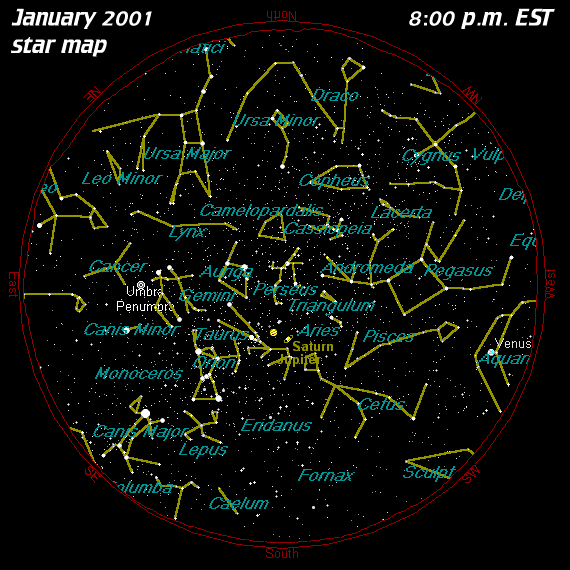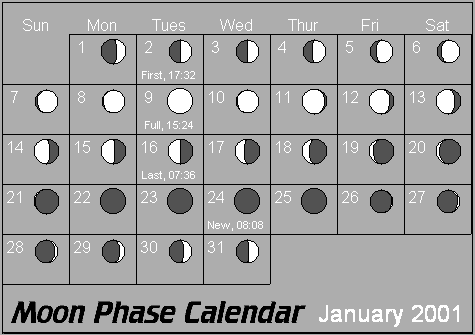![[January, Looking North]](1-01-north.gif) |
|
229  JANUARY 14, 2001:
Winter: Looking East
Gaze eastward this week as we continue our survey of the winter sky. Download a map from the web version of todayís StarWatch at the address noted below. With the Dipper now to the left, focus upon what looks like a large backwards question mark rising in the east. You are looking at the head of Leo, the Lion, also known as the Sickle. Follow the two Pointer Stars of the Dipper, Dubhe and Merak, away from the direction of the North Star to split the Lion in two. Leo continues to outline the trail of galaxies which started in the Dipper region last week. The sky which is hovering on the horizon looks away from the gas and dust-strewn plane of the Milky Way Galaxy into a much clearer region of space. When we look in this region, we penetrate deeper into the universe, and unlike the star clusters and nebulae that mark the realm of our Milky Way, we now can now view other island universes. More will be said about this in the spring. Above Leo lies a relatively bland area of sky, the home of Cancer, the Crab. Appearing like a fork in the road on a dark, rural night, the Crab would be even more obscure if it did not contain a really lovely cluster of stars. Called M44, the Beehive or the Praesepe cluster, it glows much fainter than the Pleiades, but it is nevertheless visible to the unaided eye from suburban locales. It makes a great view through a telescope at low magnifications and resembles a swarm of bees hovering around a hive. Above Cancer lies another zodiacal constellation, Gemini, the Twins, with its two bright head stars, Caster and Pollux, separated by under five degrees. Under suburban skies, it is easy to see the stick figures of the inseparable brothers who in mythologies led Roman armies to victory. JANUARY 14, 2001:
Winter: Looking East
Gaze eastward this week as we continue our survey of the winter sky. Download a map from the web version of todayís StarWatch at the address noted below. With the Dipper now to the left, focus upon what looks like a large backwards question mark rising in the east. You are looking at the head of Leo, the Lion, also known as the Sickle. Follow the two Pointer Stars of the Dipper, Dubhe and Merak, away from the direction of the North Star to split the Lion in two. Leo continues to outline the trail of galaxies which started in the Dipper region last week. The sky which is hovering on the horizon looks away from the gas and dust-strewn plane of the Milky Way Galaxy into a much clearer region of space. When we look in this region, we penetrate deeper into the universe, and unlike the star clusters and nebulae that mark the realm of our Milky Way, we now can now view other island universes. More will be said about this in the spring. Above Leo lies a relatively bland area of sky, the home of Cancer, the Crab. Appearing like a fork in the road on a dark, rural night, the Crab would be even more obscure if it did not contain a really lovely cluster of stars. Called M44, the Beehive or the Praesepe cluster, it glows much fainter than the Pleiades, but it is nevertheless visible to the unaided eye from suburban locales. It makes a great view through a telescope at low magnifications and resembles a swarm of bees hovering around a hive. Above Cancer lies another zodiacal constellation, Gemini, the Twins, with its two bright head stars, Caster and Pollux, separated by under five degrees. Under suburban skies, it is easy to see the stick figures of the inseparable brothers who in mythologies led Roman armies to victory.
| |
230  JANUARY 21, 2001:
Winter: Looking South
The winter constellations are on display in the south. Download a 10:00 p.m. StarWatch map of winterís finest at the web address below. Even a bright sodium vapor street lamp outside my home canít wash these jewels of winter from view. Theyíre visible from DC and NYC, the bright and beautiful stars of Orion, the Hunter; the Bull, Taurus; Gemini, the Twins; and the Big Dog, Canis Major. If you want to face impending stellar demise, focus your binoculars on Betelgeuse, the left shoulder of Orion, a bloated red giant of a star that Villanova astronomer, Ed Guinan, says could supernova at any moment. When it happens, it will briefly flare with nearly the intensity of the full Moon. Truly it will be the sky event of all history. If ice blue is your color, then revel at Rigel, the right knee of the Hunter. Its azure hue, astronomically, means that it is hot. Itís shining with a luminosity of nearly 60,000 suns. To Rigelís left shimmers Sirius, the brightest star of the night, only 8.6 light years distant. Below Orionís belt in his sword, youíll find the best stellar nursery in the sky, the Orion Nebula. It is home to contracting clouds of hydrogen and helium, stars to be, and stars that have just been born. Rocket up from the belt past the orangey eye of the Bull to a fuzzy patch of sky which is the Pleiades or Seven Sisters, new stars shining blue-white against black velvet. Their color is unmistakable through binoculars or a telescope at low magnifications. Below the Sisters dance Jupiter and Saturn, also worth a discerning look. Take notice to the Galilean satellites circling Jove, while the rings of Saturn are openly displayed too. Savor the moment, despite the frost and snow, for the bland sky of spring waits ready to rise in the east. JANUARY 21, 2001:
Winter: Looking South
The winter constellations are on display in the south. Download a 10:00 p.m. StarWatch map of winterís finest at the web address below. Even a bright sodium vapor street lamp outside my home canít wash these jewels of winter from view. Theyíre visible from DC and NYC, the bright and beautiful stars of Orion, the Hunter; the Bull, Taurus; Gemini, the Twins; and the Big Dog, Canis Major. If you want to face impending stellar demise, focus your binoculars on Betelgeuse, the left shoulder of Orion, a bloated red giant of a star that Villanova astronomer, Ed Guinan, says could supernova at any moment. When it happens, it will briefly flare with nearly the intensity of the full Moon. Truly it will be the sky event of all history. If ice blue is your color, then revel at Rigel, the right knee of the Hunter. Its azure hue, astronomically, means that it is hot. Itís shining with a luminosity of nearly 60,000 suns. To Rigelís left shimmers Sirius, the brightest star of the night, only 8.6 light years distant. Below Orionís belt in his sword, youíll find the best stellar nursery in the sky, the Orion Nebula. It is home to contracting clouds of hydrogen and helium, stars to be, and stars that have just been born. Rocket up from the belt past the orangey eye of the Bull to a fuzzy patch of sky which is the Pleiades or Seven Sisters, new stars shining blue-white against black velvet. Their color is unmistakable through binoculars or a telescope at low magnifications. Below the Sisters dance Jupiter and Saturn, also worth a discerning look. Take notice to the Galilean satellites circling Jove, while the rings of Saturn are openly displayed too. Savor the moment, despite the frost and snow, for the bland sky of spring waits ready to rise in the east.
| |
231  JANUARY 28, 2001:
Winter: Looking West
The western sky in January is an interesting mix of late fall and winter constellations. Fallís Great Square of Pegasus is setting by 10:00 p.m., but Andromeda, which stretches from the Square like a narrow "V," stands nearly vertically to the horizon, just north of west. Above Andromeda lies another V-shaped grouping of stars. This time the "V," signifying Perseus, the Hero, is on its side. The flanks of the "V" which open to the left, represent his legs, while the area around the vertex is Perseusí upper torso and head. With a little imagination you can see the Hero running or flying; the downward curl at the end of each leg represents Mercuryís winged sandals which allowed Perseus to fly. Gaze to the left of Perseus and youíll find the Pleiades or Seven Sisters. Jupiter and Saturn are to the Sisterís immediate left and can be seen on the web map as they might appear through a small telescope. The small V-shaped group of stars immediately to Jupiterís left is the head of the Bull. Follow the expansion of the "V" to the tip of Taurusí horns. Near the left horn can be found the location of the Great Supernova of 1054 AD. The exploding star became visible on the morning of July 5, 1054 and was seen for 23 days in broad daylight. Its brightness exceeded Venus by about 25 times, and it remained visible to the unaided eye for about two years. Today it is a telescope object, but its characteristics through the eyepiece easily allows the imagination to visualize the titanic explosion that ripped this star apart, not so long ago. At the Crabís center is a neutron star rotating over 30 times each second. See a photo of the Crab Nebula or M1 as part of this weekís StarWatch map which can be found at the web address below. JANUARY 28, 2001:
Winter: Looking West
The western sky in January is an interesting mix of late fall and winter constellations. Fallís Great Square of Pegasus is setting by 10:00 p.m., but Andromeda, which stretches from the Square like a narrow "V," stands nearly vertically to the horizon, just north of west. Above Andromeda lies another V-shaped grouping of stars. This time the "V," signifying Perseus, the Hero, is on its side. The flanks of the "V" which open to the left, represent his legs, while the area around the vertex is Perseusí upper torso and head. With a little imagination you can see the Hero running or flying; the downward curl at the end of each leg represents Mercuryís winged sandals which allowed Perseus to fly. Gaze to the left of Perseus and youíll find the Pleiades or Seven Sisters. Jupiter and Saturn are to the Sisterís immediate left and can be seen on the web map as they might appear through a small telescope. The small V-shaped group of stars immediately to Jupiterís left is the head of the Bull. Follow the expansion of the "V" to the tip of Taurusí horns. Near the left horn can be found the location of the Great Supernova of 1054 AD. The exploding star became visible on the morning of July 5, 1054 and was seen for 23 days in broad daylight. Its brightness exceeded Venus by about 25 times, and it remained visible to the unaided eye for about two years. Today it is a telescope object, but its characteristics through the eyepiece easily allows the imagination to visualize the titanic explosion that ripped this star apart, not so long ago. At the Crabís center is a neutron star rotating over 30 times each second. See a photo of the Crab Nebula or M1 as part of this weekís StarWatch map which can be found at the web address below.
| |


| 



![[January, Looking North]](1-01-north.gif)
![[January, Looking East]](1-01-east.gif)
![[January, Looking South]](1-01-south.gif)
![[January, Looking South]](1-01-west.gif)

